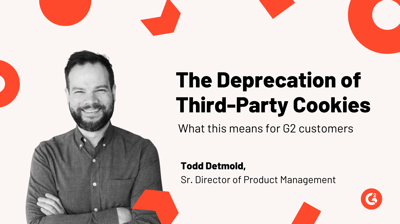
Digital advertising run through ad networks and exchanges traditionally relied on third-party cookies to track people online and personalize ads. However, rising privacy concerns are pushing for moving beyond cookies to personalize user ads.
Cookieless targeting helps you achieve this. It allows you to connect with customers in a privacy-friendly way. It’s primarily contextual targeting that uses first-party data and website content to offer personalization and keep ads relevant.
It helps you effectively engage the audience while ensuring you don’t invade anyone’s privacy. Let’s explore how you can use it to target the right users in the right spots.
Cookieless targeting delivers personalized ads to users using techniques and data sources that don’t rely on browser cookies. It uses first-party data, contextual advertising, and various advanced techniques to deliver ads.
Standard cookie-based targeting methods face multiple challenges with user privacy and regulations. Growing concerns about how businesses use customers’ data are the primary reason for finding new approaches to targeting users. Moreover, users are frustrated with the constant consent pop-ups they encounter while browsing.
Ruler analytics found that only 31% of users consent to cookies, making the cookieless approach more user-friendly and frictionless.
Before we proceed, let's quickly review how cookies help target ads so you can better understand cookieless targeting.
Advertising cookies let advertisers target customers accurately. They’re pieces of data that catalog user behavior to store information like pages visited by the user, time spent on each page, their device information, language, timezone, operating system (OS), and other details. These bits of information help target the right users for advertising or marketing.
Advertising cookies can be of the following types:
Several data protection regulations encourage companies to disclose how they use their users’ cookies. There are different ways to communicate businesses’ cookie usage, including:
Google Analytics is one of the most popular tools that employs advertising cookies to monitor user activities on a website. While advertising cookies are great for marketing campaigns, there’s an evident push for a cookieless future owing to data privacy and security concerns surrounding them.
Cookies are not malicious by nature, but since they track user activities, they make some users uncomfortable. Seldom, they may be used as a backdoor for security breaches like cross-site request forgery (CSRF) or cross-site scripting (XSS) attacks.
Presently, cookies are an integral part of digital advertising. Google has postponed its plan to phase out third-party cookies until early 2025. Mozilla Firefox’s Total Cookie Protection confines cookies to the websites where they were created and limits user behavior tracking across different websites. Apple’s Safari blocks third-party cookies that perform cross-site tracking.
If third-party cookies phase out, it will likely impact programmatic advertising. In programmatic advertising, most data comes from third-party cookies that use algorithms to purchase and sell advertising space in real time.
For general marketers, cookie depreciation would mean more challenges in personalizing ad experiences. But, it would also inspire innovation to find new techniques and ways to engage the audience without using cookies. Google’s new Privacy Sandbox initiative is along the lines of such innovations. It creates web standards for websites to access user information without compromising privacy.
Here’s a quick overview of what cookieless targeting means for advertisers, consumers, and publishers:
For advertisers, it might simply mean shifting from behavioral to contextual targeting. Audiences don’t see ads in a black box; they see them alongside other website content or landing pages. This content sets the context for the advertisement. When the context for the ad and the page’s content are the same, the ads’ relevance shines through.
A cookie-free world means excellent user experiences for consumers. It removes the creepy factor of users being racked across websites. When there are no cookies, it prevents hackers from making malicious use of them to save sensitive information.
54% of survey participants say they like ads for products and services that are highly relevant to their interests. Cookieless targeting means a higher inclination toward contextual targeting by delivering ads whose intention resonates with the page's context.
Overall, it improves the audience’s experience when browning a webpage and engaging with relevant ads.
Since publishers have a direct relationship with the audience, they will likely create comprehensive user profiles to serve ads strategically. They will rely on first-party data to capture unique user information at scale in a cookieless future.
Publishers can pivot toward contextual targeting and probabilistic audience modeling to recover the loss in ad revenue. Probabilistic audience modeling is a statistical technique that uses predictive algorithms to create customer profiles. It can be used to measure campaign performance, understand consumer behavior, and predict future events.
Cookieless targeting and contextual targeting are the same, which means they’ve been used in advertising for some time. Here’s how you can target the audience without cookies through the contextual route:
First-party data (1PD) comes directly from users who willingly share it through their interactions with your website, mobile app, and other owned channels. 1PD is basically what you collect through digital analytics software.
Server-side tracking bypasses the need for third-party cookies by sending user data directly to a website’s server. Adtech platforms can connect with these server to get the data, provided they have the required consent. This helps advertisers understand the target audience better and contextually deliver remarketing campaigns.
Businesses can rely on tag management systems to employ server-side tracking. These systems embed a short JavaScript on webpages, mobile applications, and other digital channels to collect first-party user data.
Contextual advertising targets ads based on the context of a website page rather than using data or tracking cookies. This allows you to deliver targeted and relevant advertisements to users while complying with privacy regulations.
This advertising type is about delivering the right message at the right time and place. When ads are shown in the context of a webpage, they automatically become relevant to the user and make a more significant impact.
According to estimates, contextual advertising spending reached 227.38 billion U.S. dollars worldwide in 2023. By 2030, it is predicted to reach 562.1 billion dollars, more than doubling. Here’s how it’s predicted to grow:
Source: Statista
Yes, the market and spending are increasing at a decent pace. This is due to the return on investment that advertisers get from contextual targeting.
According to Analytics Partners' report, contextual targeting is 1.2x to 2.5x more effective than other forms of targeting. They cater to users’ interests, making ads relevant and more effective in engaging the audience base.
Use unique identifiers like phone numbers or email IDs to target users across different platforms. When you adopt an identity-based solution, you can build a detailed user profile across channels, profiles, and devices. This makes it easier for you to target ads.
Identity resolution software allows businesses to recognize the unique digital identity of individual customers so they can develop highly personalized campaigns to target them.
Device fingerprinting makes it easier to identify devices without relying on cookies based on various attributes of a user's device. When a user visits a website, this data is captured and stored as a unique identifier known as a device's fingerprint. It makes it easy to identify the same device across sessions.
This data allows advertisers to target ads effectively without relying on traditional cookies.
G2’s Buyer Intent doesn’t come from third-party. Buyer Intent offers rich data based on users’ activity in G2’s marketplace that correlates with purchasing intention.
Since G2 owns the marketplace where 90 million buyers come to discover and buy software every year, the buyer intent data is all first-party and privacy-compliant. Using it can be a reliable way to target potential customers.
Cookieless targeting increases the relevancy of an advertisement shown to users, making it more effective in engaging them. Considering its benefits, around 47% of marketers have planned to work on a cookie-free targeting approach as of September 2023.
Cookieless advertising offers a delightful user experience while complying with application privacy regulations. Here's how to start adopting cookieless targeting in advertising:
Quick takeaways on how to start with cookieless targeting:
Cookieless targeting will let you promote niche-specific ads on web pages whose content resonates with the niche you’re targeting.
Learn more about why the deprecation of third-party cookies is inconsequential for G2 Buyer Intent users.
Sagar Joshi is a former content marketing specialist at G2 in India. He is an engineer with a keen interest in data analytics and cybersecurity. He writes about topics related to them. You can find him reading books, learning a new language, or playing pool in his free time.
For years, marketers have relied on cookies, or little data files that contain personal...
 by Alyssa Quander Riley
by Alyssa Quander Riley
For several years now, marketers and technology vendors alike have been preparing for the ...
 by Todd Detmold
by Todd Detmold
Since Google announced the elimination of third-party cookies and Apple announced changes that...
 by Hannah Stewart
by Hannah Stewart
For years, marketers have relied on cookies, or little data files that contain personal...
 by Alyssa Quander Riley
by Alyssa Quander Riley
For several years now, marketers and technology vendors alike have been preparing for the ...
 by Todd Detmold
by Todd Detmold


